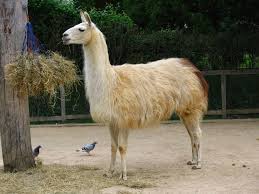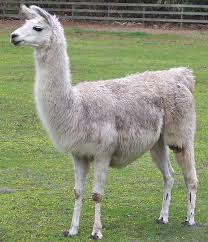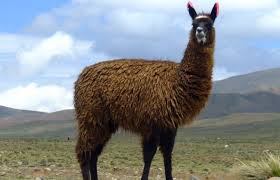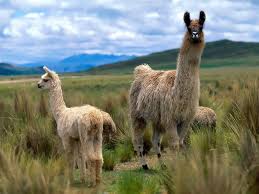The llama is a domesticated South American camelid, widely used as a meat and pack animal by Andean cultures
since the Pre-Columbian era.
The height of a full-grown, full-size llama is 1.7 to 1.8 m (5.6 to 5.9 ft) tall at the top of the head, and
can weigh between 130 and 200 kg (290 and 440 lb). At birth, a baby llama (called a cria) can weigh between
9 and 14 kg (20 and 31 lb). Llamas typically live for 15 to 25 years, with some individuals surviving 30
years or more.
They are very social animals and live with other llamas as a herd. The wool produced by a llama is very soft
and lanolin-free. Llamas are intelligent and can learn simple tasks after a few repetitions. When using a
pack, they can carry about 25 to 30% of their body weight for 8 to 13 km (5-8 miles).
The name llama (in the past also spelled 'lama' or 'glama') was adopted by European settlers from native
Peruvians.
Llamas appear to have originated from the central plains of North America about 40 million years ago. They
migrated to South America about three million years ago. By the end of the last ice age (10,000-12,000 years
ago), camelids were extinct in North America. As of 2007, there were over seven million llamas and alpacas
in South America, and due to importation from South America in the late 20th century, there are now over
158,000 llamas and 100,000 alpacas in the United States and Canada.
Description
The following characteristics apply especially to llamas. Dentition of adults:-incisors 1/3 canines 1/1,
premolars 2/2, molars 3/2; total 32. In the upper jaw, a compressed, sharp, pointed laniariform incisor near
the hinder edge of the premaxilla is followed in the male at least by a moderate-sized, pointed, curved true
canine in the anterior part of the maxilla. The isolated canine-like premolar that follows in the camels is
not present. The teeth of the molar series, which are in contact with each other, consist of two very small
premolars (the first almost rudimentary) and three broad molars, constructed generally like those of
Camelus. In the lower jaw, the three incisors are long, spatulate, and procumbent; the outer ones are the
smallest.

Next to these is a curved, suberect canine, followed after an interval by an isolated minute and
often deciduous simple conical premolar; then a contiguous series of one premolar and three molars, which
differ from those of Camelus in having a small accessory column at the anterior outer edge.
Reproduction
Llamas have an unusual reproductive cycle for a large animal. Female llamas are induced ovulators. Through
the act of mating, the female releases an egg and is often fertilized on the first attempt. Female llamas
do not go into estrus ("heat").
Like humans, llama males and females mature sexually at different rates. Females reach puberty at about 12
months old; males do not become sexually mature until around three years of age.
The gestation period of a llama is 11.5 months (350 days). Dams (female llamas) do not lick off their babies,
as they have an attached tongue that does not reach outside of the mouth more than half an inch (1.3 cm).
Rather, they will nuzzle and hum to their newborns.
A cria (from Spanish for "baby") is the name for a baby llama, alpaca, vicuña, or guanaco. Crias are
typically born with all the females of the herd gathering around, in an attempt to protect against the male
llamas and potential predators. Llamas give birth standing. Birth is usually quick and problem-free, over in
less than 30 minutes. Most births take place between 8 am and noon, during the warmer daylight hours. This
may increase cria survival by reducing fatalities due to hypothermia during cold Andean nights. This
birthing pattern is speculated to be a continuation of the birthing patterns observed in the wild. Crias are
up and standing, walking and attempting to suckle within the first hour after birth. Crias are partially fed
with llama milk that is lower in fat and salt and higher in phosphorus and calcium than cow or goat milk. A
female llama will only produce about 60 ml (2.1 imp fl oz) of milk at a time when she gives milk, so the cria
must suckle frequently to receive the nutrients it requires.








